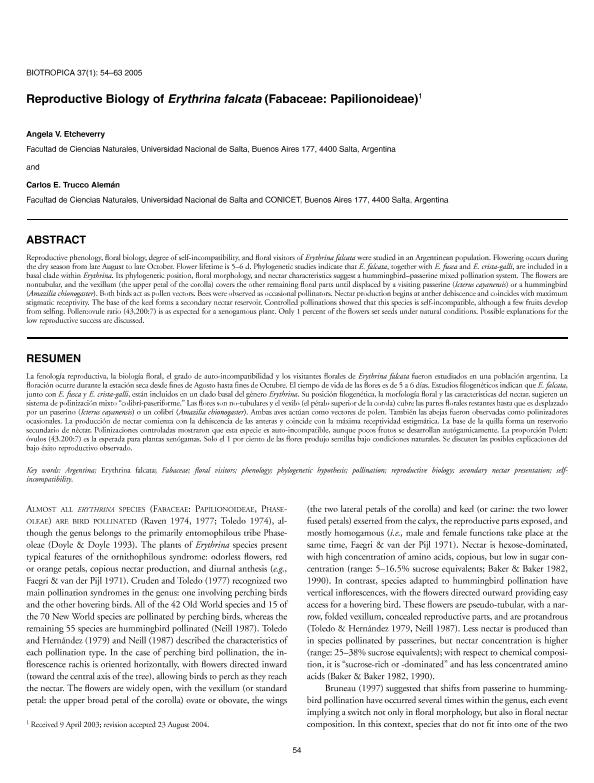Artículo
Reproductive biology of Erythrina falcata (Fabaceae: Papilionoideae)
Fecha de publicación:
03/2005
Editorial:
Wiley Blackwell Publishing, Inc
Revista:
Biotropica
ISSN:
0006-3606
Idioma:
Inglés
Tipo de recurso:
Artículo publicado
Clasificación temática:
Resumen
Reproductive phenology, floral biology, degree of self-incompatibility, and floral visitors of Erythrina falcata were studied in an Argentinean population. Flowering occurs during the dry season from late August to late October. Flower lifetime is 5-6 d. Phylogenetic studies indicate that E. falcata, together with E. fusca and E. crista-galli, are included in a basal clade within Erythrina. Its phylogenetic position, floral morphology, and nectar characteristics suggest a hummingbird-passerine mixed pollination system. The flowers are nontubular, and the vexillum (the upper petal of the corolla) covers the other remaining floral parts until displaced by a visiting passerine (Icterus cayanensis) or a hummingbird (Amazilia chionogaster). Both birds act as pollen vectors. Bees were observed as occasional pollinators. Nectar production begins at anther dehiscence and coincides with maximum stigmatic receptivity. The base of the keel forms a secondary nectar reservoir. Controlled pollinations showed that this species is self-incompatible, although a few fruits develop from selfing. Pollen:ovule ratio (43,200:7) is as expected for a xenogamous plant. Only 1 percent of the flowers set seeds under natural conditions. Possible explanations for the low reproductive success are discussed.
Archivos asociados
Licencia
Identificadores
Colecciones
Articulos(CCT - SALTA-JUJUY)
Articulos de CTRO.CIENTIFICO TECNOL.CONICET - SALTA-JUJUY
Articulos de CTRO.CIENTIFICO TECNOL.CONICET - SALTA-JUJUY
Citación
Etcheverry, Angela Virginia; Trucco Aleman, Carlos Eduardo; Reproductive biology of Erythrina falcata (Fabaceae: Papilionoideae); Wiley Blackwell Publishing, Inc; Biotropica; 37; 1; 3-2005; 54-63
Compartir
Altmétricas




